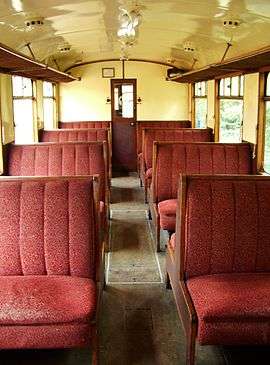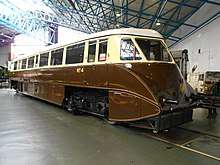GWR railcars
| GWR railcars | |
|---|---|
|
Preserved AEC railcar No. 22 | |
 The interior of railcar 22 | |
| In service | 1934–1962 |
| Constructed | 1934–1942 |
| Number built | 38 cars |
| Number preserved | 3 cars |
| Operator(s) |
Great Western Railway British Rail (Western Region) |
| Specifications | |
| Train heating | steam heating |
| Track gauge | 4 ft 8 1⁄2 in (1,435 mm) standard gauge |
In 1933, the Great Western Railway introduced the first of what was to become a very successful series of railcars, which survived in regular use into the 1960s, when they were replaced with the new British Rail "first generation" type diesel multiple units.
Design
Bodywork
The original design featured streamlined bodywork, which was very much the fashion at the time. The rounded lines of the first examples built led to their nickname: "flying banana". The preserved W4W is an example of the original, rounded body shape. Later "razor edge" examples, such as No. 22 (pictured), had much more angular (and practical) bodywork, yet the nickname persisted for these too.
Heating
An odd feature of these units was the fitting of steam heating to them, which had the power to heat the railcar and another two to three coaches.
Powertrain
An unusual feature was the external cardan shaft drive from the gearbox on the rear of a horizontally mounted engine to road-vehicle style reduction boxes outboard of the two axles on one bogie. Later units had two such engine and drive combinations placed on opposite sides. Railcars 19-20 were fitted with a separate high-low ratio gearbox on the final drive side of the gearbox. This allowed a top speed of about 60–70 mph (97–113 km/h) in high and about 40–45 mph (64–72 km/h) in low. Railcar W20W retains this in preservation.
Fleet list
| Number Range | Introduced | Builder | Engine | Weight (long tons) | Seats | Withdrawn | Notes |
|---|---|---|---|---|---|---|---|
| 1 | 1934 | Park Royal | 1 AEC of 130 hp (97 kW) | 24 long tons (24.4 t; 26.9 short tons) | 69 | 1955 | Prototype railcar |
| 2–4 | 1934 | 2 AEC of 130 hp (97 kW) | 26.2 long tons (26.6 t; 29.3 short tons) | 44 | 1954–1958 | Buffet fitted | |
| 5–7 | 1935 | Gloucester RCW | 25.3 long tons (25.7 t; 28.3 short tons) | 70 | 1957–59 | Standard single car | |
| 8–9, 13–16 | 1936 | 29.5 long tons (30.0 t; 33.0 short tons) | 70 | 1957–60 | 9 withdrawn in 1946 after fire | ||
| 10–12 | 1936 | 29.9 long tons (30.4 t; 33.5 short tons) | 63 | 1956–57 | Lavatory fitted | ||
| 17 | 1936 | 28.85 long tons (29.31 t; 32.31 short tons) | None | 1959 | Parcels car, capacity 10 long tons (10.2 t; 11.2 short tons) | ||
| 18 | 1937 | 33.6 long tons (34.1 t; 37.6 short tons) | 49 | 1957 | Prototype, with buffers & draw gear for hauling vans | ||
| 19–33 | 1940–41 | GWR, Swindon | 2 AEC of 105 hp (78 kW) | 35.65 long tons (36.22 t; 39.93 short tons) | 48 | 1960–62 | 33 rebuilt in 1954 to replace 37 |
| 34 | 1941 | 34.9 long tons (35.5 t; 39.1 short tons) | None | 1960 | Parcels car, capacity 10 long tons (10.2 t; 11.2 short tons) | ||
| 35–38 | 1941–42 | 36.7 long tons (37.3 t; 41.1 short tons) + 37.6 long tons (38.2 t; 42.1 short tons) |
60 + 44 | 1957, 1962 | Power twins with buffet and lavatory 35+36 and 37+38 37 withdrawn in 1949 after fire and replaced by 33 | ||
Five of the 38 railcars were destroyed by fires:[1]
- No 9 was burnt out at Heyford in July 1945; officially condemned in May 1946
- No 10 was burnt out at Bridgnorth in March 1956; officially condemned in May 1956
- No 35 and No 36 were destroyed by fire at St Anne's Park, Bristol in April 1956; officially condemned in April 1957
- No 37 was damaged by fire in February 1949 and was stored until being scrapped; officially condemned in September 1949
Preservation
Three of the GWR railcars have survived into preservation, as follows:
| Vehicle No. | Builder | Year Built | Location | Comments | Photograph |
|---|---|---|---|---|---|
| W4W | Park Royal | 1934 | National Railway Museum, York[2] | Static Display |  |
| W20W | GWR Swindon | 1940 | Kent & East Sussex Railway | Under restoration at Tenterden since 1983. |  |
| W22W | GWR Swindon | 1940 | Didcot Railway Centre | Operational. | |
Models
Hornby Railways manufacture a model of the 1940-style railcar in OO gauge, using tooling acquired in their takeover of Lima. In late 2017, Dapol released an OO model of the streamlined 1936 Gloucester RCW railcars in a variety of liveries and numbers. Graham Farish has produced an N-gauge model (with various numbers, e.g. 19, 22, and 20), both before and after their takeover by Bachman.
See also
References
- ↑ Judge, Colin (2008). The History of the Great Western A.E.C. Diesel Railcars. Kevin Robertson (Noodle Books). p. 227. ISBN 9781906419110.
- ↑ "Back home! Swindon legends go back on display". The Railway Magazine. Vol. 161 no. 1, 377. Horncastle, Lincs: Mortons Media Group. 2 December 2015. p. 9. ISSN 0033-8923.
Further reading
- Allen, Geoffrey Freeman (February 1983). "The GWR's Flying Bananas". Rail Enthusiast. EMAP National Publications. pp. 26–31. ISSN 0262-561X. OCLC 49957965.
- Riley, Dick (May 1983). "Railcars remembered". Rail Enthusiast. EMAP National Publications. pp. 32–35. ISSN 0262-561X. OCLC 49957965.
External links
| Wikimedia Commons has media related to GWR railcars. |